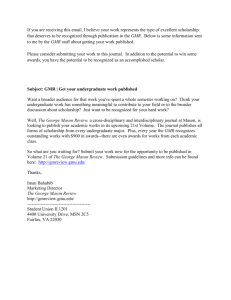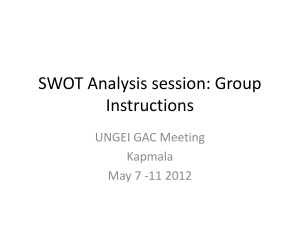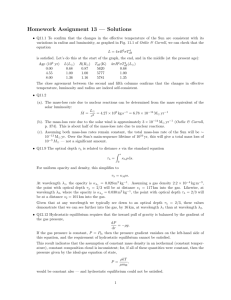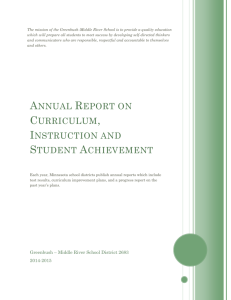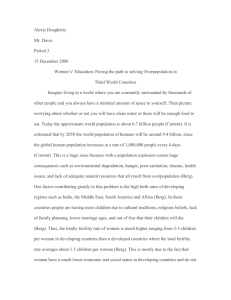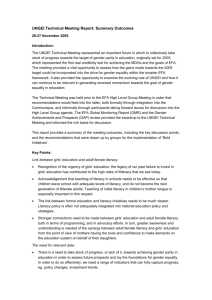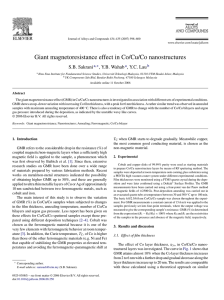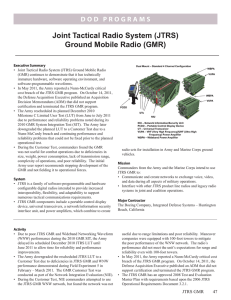GMR 2011:A Review from the Perspective of Gender and the
advertisement
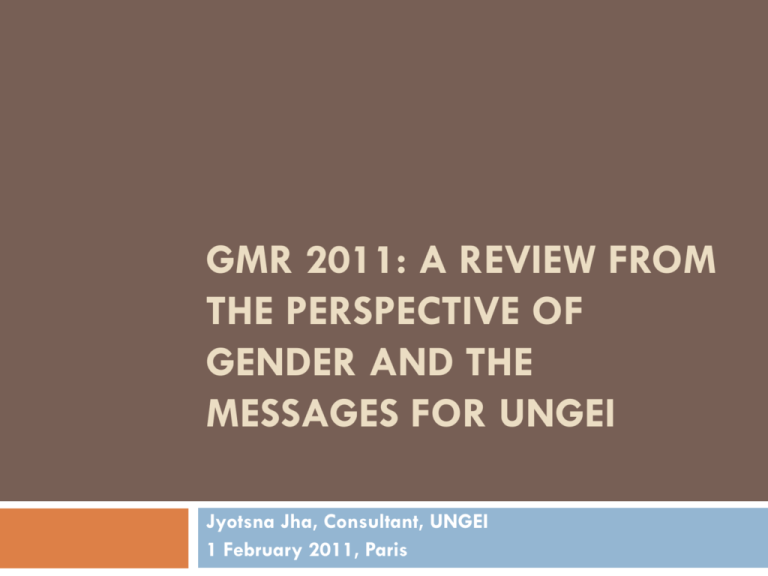
GMR 2011: A REVIEW FROM THE PERSPECTIVE OF GENDER AND THE MESSAGES FOR UNGEI Jyotsna Jha, Consultant, UNGEI 1 February 2011, Paris GMR 2011 Part I: Strengths and Gaps The focus on most vulnerable / marginalised maintained throughout the report; Coverage of and focus on gender issues uneven Both intrinsic and instrumental aspects of female education included though tilted towards latter in providing evidences Gender analysis evident in goals where girls / women / gender figure as a special concern/focus but either weak or missing for other goals (Goals 1 and 3) Focus on gender parity issues in primary and secondary education highlighting the importance of a continuum approach but weak in the the coverage of and focus on gender equality issues / linkages. The issue of male underachievement now common in many high and middle income countries at secondary level not given much attention. GMR 2011 Part II: Strengths and Gaps Extensive analysis of education /child related issues in conflict areas for the first time; Acknowledging the information/data-gaps and therefore limitations of estimates / extrapolations but not being restricted by those in carrying out analyses Identification of rape, sexual violence and other violations / protection /reporting / response related issues as major barriers for girl’s education in addition to direct attack on schools / children / girls in conflict areas in a comprehensive manner; some gaps exist The analysis of conflict areas include the issues of refugees and internally displaced people; a fine gender analysis in most cases but some gaps exist GMR 2011 : Strengths and Gaps The report rightly recognizes the critical role that school curricula can play in fuelling conflict or promoting peace but it misses the point that it can also do that for gender norms and practices in general and in conflict/post-conflict situations in particular Good analysis of gaps in financing in general and during the economic downturn; the need for reforming the aid architecture in general and conflict areas in particular; gender aspects could be strengthened (e.g., the impact of food crisis) GMR 2011 Part I: Main messages The world is not on track in achieving universal primary education. Progress in the last three years slower than the previous six years. Being female, poor and living in a country affected by conflict are three of the most pervasive risk factors for children being out of school. Persistent gender disadvantage in some regions (59% of out of school children in South and West Asia are girls); girls disadvantaged at every stage - entry at right age, survival, quality education and completion. Known barriers (early marriage, perception that education is not critical for girls, high perceived and real costs, poverty) continue to play a role against girls’ education GMR 2011 Part I: Main messages Nutrition and ECE participation critical for later success and completion at primary and secondary levels. Strong linkages with maternal education; Adult illiteracy, especially female illiteracy, is declining but not fast enough; Inadequate public funding for ECCE and literacy programmes Learning achievement is invariably associated with factors such as parental wealth and education, language, ethnicity and geographic location. Poor girls are likely to suffer more because of low parental support / willingness to spend The issue of gender equality within education: redefining quality to include empowerment issues and making educational processes gender – equal would be important in the long run (school, youth and literacy programmes) GMR 2011 Part I: Main messages The situation at secondary level more uneven but most disparities can be traced to primary level; higher disparities in labour market where the gender gaps reduce much more slowly Economic downturn has clearly affected the job market adversely; new job creations concentrated in high-skill area while much of job destruction is happening in low-skill areas leading to further marginalisation of lowly educated youth, especially women Several developing countries reduced the share of national income on education; reduction on fiscal spending might affect education investment further; Quality of spending and governance as important – efficiency and commitment to equity critical to determine the outcome; donor commitments unfulfilled despite increase; need for new instruments GMR 2011 Part II: Main messages The impact of armed conflict has been underestimated. Gender disparities are significantly higher at both primary and secondary levels (the gap being wider at secondary) in conflict-affected comparable income level countries not affected by conflict Being a civilian – especially a female civilian – is far more dangerous than being in the armed services. Diseases that follow wars and the widespread displacement, destruction of assets and infrastructure, and disruption of livelihoods cause far more/higher deaths, malnutrition and vulnerability. In several long-running conflicts, armed groups have used attacks on school children and teachers to ‘punish’ participation in state institutions. Groups opposed to gender equity in education have targeted girls in particular (Afghanistan and Pakistan). GMR 2011 Part II: Main messages Children subject to the trauma, insecurity and displacement that come with armed conflict are unlikely to achieve their potential for learning. Rape and sexual violence used as a weapon of war: with direct and indirect consequences for education (Psychological trauma, stigma, fear of such violence, women’s mobility, access to health care often missing for victims and others facing trauma, redefined social and gender norms). Poor reporting, lack of effective law and other instruments (national and international) Conflict diverts resources from education. Many of the poorest countries spend significantly more on arms than on basic education. GMR 2011 Part II: Main messages High levels of gender disparity - a common feature of many refugee camps; ‘temporary’ status accorded to refugees deter investment beyond the primary level. The situation for IDPs is worse as there is no legally binding instrument upholding the rights of IDPs. Humanitarian aid is intended to save lives, sustain access to vital services and maintain human dignity. Education is seen as a less immediate priority – needs to change. Humanitarian aid fragmented and not necessarily well coordinated. Wide reforms needed in aid architecture. Education Needs are often poorly assessed and planning cycles are too short to allow for long terms views. Education is doubly disadvantaged- a small share of requests and the smallest percentage of requests attended to within humanitarian aid. UNGEI Message for the EFA Working Group (Donors and National Governments) Need to understand the strong interrelationships and therefore comprehensive policy / funding /aid response. Several interrelationships are critical: (i) nutrition - education – nutrition linkages, (ii) educational continuum – entry at right age to survival to quality in primary education for transition and completion of secondary education, (iii) maternal (or, parental?) education and empowerment – nutrition/care/education for girls linkages, and (iv) protection – education linkages. Greater investment on ECCE and youth/adult literacy programmes to make them more accessible to girls and children facing greater vulnerability to achieve all the EFA goals. Inter-departmental coordination becomes critical. UNGEI Message for the EFA Working Group (Donors and National Governments) Educational curricula and processes can play a major role in changing a large number of gender related practices, norms and beliefs including those linked to violence against women/girls and sexual abuse. Hence, the need for tailoring the educational interventions in general and in conflict areas in particular. The notion of quality of education needs to undergo a change to incorporate values of equality, diversity and respect. UNGEI Message for the EFA Working Group (Donors and National Governments) Enhancing social/economic security schemes / coverage can help in reducing the adverse impact caused by economic downturn/uncertainties; Fiscal adjustments might mean reduced revenue collection and therefore the need for (i) maintaining investment on education in the exercise, (ii) Innovative strategies for funding education (Global Education Fund?) and (iii) ways of ensuring enhanced aid effectiveness Strengthening the gender component of FTI through formal UNGEI engagement in review/planning/monitoring processes UNGEI Message for the EFA Working Group (Donors and National Governments) The need to recognise that protection, gender and educational policies are integral parts of aid policy in conflict areas and reforming the aid architecture in that light. The reform should take note of the following issues: (i) the divide between humanitarian and development aid is artificial, (ii) aid cycle for humanitarian aid also needs to be longer to enable effective planning and implementation, (iii) pooled funding and coordinated monitoring enable much more efficient use of aid, and (iv) strengthening gender component of education clusters and expanding the role of education clusters in need assessment would be important. UNGEI Engagement with GMR processes, report and dissemination Develop a gender review framework for the forthcoming GMR theme and make it available to the GMR team as well as the wider audience Continue with the annual gender review of the GMR Advocate for a formal UNGEI representative in the GMR Board Strengthen the dissemination exercise through various means: carrying out regional gender reviews and sharing at regional levels – also making use of the background papers THANK YOU
